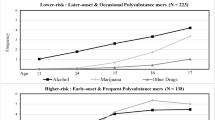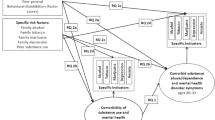Abstract
Objectives
Since the number of individuals who use substances in the United States has markedly increased every year, substance use is a significant public health concern. The current study examines the possible risk and protective factors associated with triple comorbid trajectories of longitudinal alcohol, tobacco, and cannabis use from age 14 to 36.
Methods
A community sample of 674 participants (53% African Americans and 47% Puerto Ricans; 60% females) were recruited from the Harlem Longitudinal Development Study. Multinomial logistic regression analyses were conducted to examine the associations between the risk (low self-control, peer drug use) and protective (parent-child attachment, family church attendance) factors at age 14 and membership in the triple trajectory groups derived from a multivariate growth mixture model.
Results
Low self-control and peer drug use were associated with an increased likelihood of being a member in the triple comorbid trajectory groups compared to the reference group (i.e., low alcohol, no tobacco, and no cannabis use). On the other hand, parent-child attachment and family church attendance were associated with a decreased likelihood of being a member in the triple comorbid trajectory groups compared to the reference group.
Conclusions
Treatment programs for adolescents who use substances may be more helpful if their parents and/or friends could also participate together with the adolescent, rather than only the adolescent participates in the treatment programs. Further research is needed to gain a greater understanding of the conceptual nature of the relationship between earlier risk and protective factors and later substance use patterns.


Similar content being viewed by others
References
Agrawal, A., Scherrer, J. F., Grant, J. D., Sartor, C. E., Pergadia, M. L., Duncan, A. E., & Bucholz, K. K. (2010). The effects of maternal smoking during pregnancy on offspring outcomes. Preventive Medicine, 50(1), 13–18. https://doi.org/10.1016/j.ypmed.2009.12.009.
Asbridge, M., Hayden, J. A., & Cartwright, J. L. (2012). Acute cannabis consumption and motor vehicle collision risk: systematic review of observational studies and meta-analysis. BMJ, 344, e536. https://doi.org/10.1136/bmj.e536.
Beaver, K. M., Al-Ghamdi, M. S., Kobeisy, A. N., Alqurashi, F. H., Schwartz, J. A., Connolly, E. J., & Gajos, J. M. (2016). The effects of low self-control and delinquent peers on alcohol, tobacco, and drug use in a sample of Saudi Arabian youth. International Journal of Offender Therapy and Comparative Criminology, 60(13), 1569–1587. https://doi.org/10.1177/0306624X15583670.
Bouchery, E. E., Harwood, H. J., Sacks, J. J., Simon, C. J., & Brewer, R. D. (2011). Economic costs of excessive alcohol consumption in the US, 2006. American Journal of Preventive Medicine, 41(5), 516–524. https://doi.org/10.1016/j.amepre.2011.06.045.
Brook, J. S., Brook, D. W., Gordon, A. S., Whiteman, M., & Cohen, P. (1990). The psychological etiology of adolescent drug use: a family interactional approach. Genetic, Social, and General Psychology Monographs, 116, 111–267.
Brook, J. S., Lee, J. Y., Brown, E. N., & Finch, S. J. (2012a). Comorbid trajectories of tobacco and marijuana use as related to psychological outcomes. Substance Abuse, 33(2), 156–167. https://doi.org/10.1080/08897077.2011.640202.
Brook, J. S., Lee, J. Y., Finch, S. J., & Brown, E. N. (2012b). The association of externalizing behavior and parent–child relationships: an intergenerational study. Journal of Child and Family Studies, 21(3), 418–427.
Brook, J. S., Lee, J. Y., Rubenstone, E., Brook, D. W., & Finch, S. J. (2014). Triple comorbid trajectories of tobacco, alcohol, and marijuana use as predictors of antisocial personality disorder and generalized anxiety disorder among urban adults. American Journal of Public Health, 104(8), 1413–1420. https://doi.org/10.2105/AJPH.2014.301880.
Centers for Disease Control and Prevention (2008). Alcohol-related disease impact (ARDI). Atlanta, GA: Author.
de Ridder, D. T., Lensvelt-Mulders, G., Finkenauer, C., Stok, F. M., & Baumeister, R. F. (2012). Taking stock of self-control: A meta-analysis of how trait self-control relates to a wide range of behaviors. Personality and Social Psychology Review, 16(1), 76–99. https://doi.org/10.1177/1088868311418749.
Dick, D. M., & Agrawal, A. (2008). The genetics of alcohol and other drug dependence. Alcohol Research & Health, 31(2), 111.
Farmer, R. F., Seeley, J. R., Kosty, D. B., Gau, J. M., Duncan, S. C., Lynskey, M. T., & Lewinsohn, P. M. (2015). Internalizing and externalizing psychopathology as predictors of cannabis use disorder onset during adolescence and early adulthood. Psychology of Addictive Behaviors, 29(3), 541–551. https://doi.org/10.1037/adb0000059.
Franken, A., Moffitt, T. E., Steglich, C. E., Dijkstra, J. K., Harakeh, Z., & Vollebergh, W. A. (2016). The role of self-control and early adolescents’ friendships in the development of externalizing behavior: the SNARE study. Journal of Youth and Adolescence, 45(9), 1800–1811. https://doi.org/10.1007/s10964-015-0287-z.
Friedmann, P. D. (2013). Alcohol use in adults. New England Journal of Medicine, 368(4), 365–373. https://doi.org/10.1056/NEJMcp1204714.
Goldman, D., Oroszi, G., & Ducci, F. (2006). The genetics of addictions: uncovering the genes. Focus, 6(3), 521–415.
Gottfredson, M. R., & Hirschi, T. (1990). A general theory of crime. Palo Alto, CA: Stanford University Press.
Gray, T. R., Eiden, R. D., Leonard, K. E., Connors, G. J., Shisler, S., & Huestis, M. A. (2010). Identifying prenatal cannabis exposure and effects of concurrent tobacco exposure on neonatal growth. Clinical Chemistry, 56(9), 1442–1450. https://doi.org/10.1373/clinchem.2010.147876.
Harrison, L, Martin, S, Enev, T., & Harrington, D. (2007). Comparing drug testing and self-report of drug use among youths and young adults in the general Studies. Rockville, MD: Substance Abuse and Mental Health Services Administration, Office of Applied Studies.
Hawkins, J. D., Catalano, R. F., & Miller, J. Y. (1992). Risk and protective factors for alcohol and other drug problems in adolescence and early adulthood: implications for substance abuse prevention. Psychological Bulletin, 112(1), 64.
Hoffmann, J. P., & Bahr, S. J. (2014). Parenting style, religiosity, peer alcohol use, and adolescent heavy drinking. Journal of Studies on Alcohol and Drugs, 75(2), 222–227.
Jackson, K. M., Sher, K. J., & Schulenberg, J. E. (2008). Conjoint developmental trajectories of young adult substance use. Alcoholism: Clinical and Experimental Research, 32(5), 723–737. https://doi.org/10.1111/j.1530-0277.2008.00643.x.
Jamal, A., Homa, D. M., O’Connor, E., Babb, S. D., Caraballo, R. S., Singh, T., & King, B. A. (2015). Current cigarette smoking among adults—United States, 2005–2014. MMWR Morbidity Mortality Wkeely Report, 64(44), 1233–1240. https://doi.org/10.15585/mmwr.mm6444a2.
Johnston, L. D., O'Malley, P. M., Bachman, J. G., & Schulenberg, J. E. (2012). Monitoring the future national results on adolescent drug use: Overview of key findings, 2011. Bethesda, MD: National Institues of Health.
Karila, L., Roux, P., Rolland, B., Benyamina, A., Reynaud, M., Aubin, H.-J., & Lançon, C. (2014). Acute and long-term effects of cannabis use: a review. Current Pharmaceutical Design, 20(25), 4112–4118. https://doi.org/10.2174/13816128113199990620.
Khavari, K. A., & Harmon, T. M. (1982). The relationship between the degree of professed religious belief and use of drugs. International Journal of the Addictions, 17(5), 847–857. https://doi.org/10.3109/10826088209056331.
Lee, J.Y., Brook, J.S., De La Rosa, M., Kim, Y., & Brook, D.W. (2017). The association between alcohol use trajectories from adolescence to adulthood and cannabis use disorder in adulthood: a 22-year longitudinal study. The American Journal of Drug and Alcohol Abuse, 1–7. https://doi.org/10.1080/00952990.2017.1288734
McCabe, S. E., Morales, M., Cranford, J. A., Delva, J., McPherson, M. D., & Boyd, C. J. (2007). Race/ethnicity and gender differences in drug use and abuse among college students. Journal of Ethnicity in Substance Abuse, 6(2), 75–95. https://doi.org/10.1300/J233v06n02_06.
Muthén, L., & Muthén, B. (2010). Mplus user’s guide. 6th ed. Los Angeles, CA: Muthén & Muthén.
Newman, K., Harrison, L., Dashiff, C., & Davies, S. (2008). Relationships between parenting styles and risk behaviors in adolescent health: an integrative literature review. Revista Latino-Americana De Enfermagem, 16(1), 142–150. https://doi.org/10.1590/S0104-11692008000100022.
NIDA. (2014). NIH: National Instutute on Drug Abuse. Research report series marijuana. https://www.drugabuse.gov/drugs- abuse/marijuana. Accessed 26 May 2016 (Accession No. 15-3859).
Pokhrel, P., Unger, J. B., Wagner, K. D., Ritt-Olson, A., & Sussman, S. (2008). Effects of parental monitoring, parent–child communication, and parents’ expectation of the child’s acculturation on the substance use behaviors of urban, Hispanic adolescents. Journal of Ethnicity in Substance Abuse, 7(2), 200–213. https://doi.org/10.1080/15332640802055665.
Rehm, J., Gmel, G., Sempos, C. T., & Trevisan, M. (2003). Alcohol-related morbidity and mortality. Alcohol Research & Health, 27(1), 39–51.
Substance Abuse and Mental Health Services Administration, (SAMHSA) (2014). Results from the 2013 national survey on drug use and health: summary of national findings (Vol. NSDUH series H-49, HHS publication no. (SMA) 14–4887). Rockville, MD: Author.
Substance Abuse and Mental Health Services Adminstration, (SAMHSA) (2015). Behavioral health trends in the United States: results from the 2014 national survey on drug use and health. Rockville, MD: Author.
Sanchez‐Roige, S., Fontanillas, P., Elson, S. L., Me Research, T., Gray, J. C., de Wit, H., & Palmer, A. A. (2019). Genome‐wide association study of alcohol use disorder identification test (AUDIT) scores in 20 328 research participants of European ancestry. Addiction Biology, 24(1), 121–131.
Schulenberg, J. E., Merline, A. C., Johnston, L. D., O’Malley, P. M., Bachman, J. G., & Laetz, V. B. (2005). Trajectories of marijuana use during the transition to adulthood: the big picture based on national panel data. Journal of Drug Issues, 35(2), 255–280.
Warren, J. R., Luo, L., Halpern-Manners, A., Raymo, J. M., & Palloni, A. (2015). Do different methods for modeling age-graded trajectories yield consistent and valid results? American Journal of Sociology, 120(6), 1809–1856. https://doi.org/10.1086/681962.
Wills, T. A., Knight, R., Williams, R. J., Pagano, I., & Sargent, J. D. (2015). Risk factors for exclusive e-cigarette use and dual e-cigarette use and tobacco use in adolescents. Pediatrics, 135(1), e43–e51. https://doi.org/10.1542/peds.2014-0760.
Xu, X., Bishop, E. E., Kennedy, S. M., Simpson, S. A., & Pechacek, T. F. (2015). Annual healthcare spending attributable to cigarette smoking: an update. American Journal of Preventive Medicine, 48(3), 326–333. https://doi.org/10.1016/j.amepre.2014.10.012.
Yankey, B. N., Strasser, S., & Okosun, I. S. (2016). A cross-sectional analysis of the association between marijuana and cigarette smoking with metabolic syndrome among adults in the United States. Diabetes & Metabolic Syndrome: Clinical Research & Reviews, 10(2), S89–S95. https://doi.org/10.1016/j.dsx.2016.03.001.
Acknowledgements
This research was supported in part by Career Development Award (5 K01 DA041609) granted to Dr. Lee from the National Institute on Drug Abuse.
Author Contributions
JYL: designed and executed the study, analyzed the data, and wrote the manuscript. WK: collaborated with the data analyses, interpretation of the results, and preparation of the manuscript. JSB: collaborated with design and writing of the manuscript. SJF: collaborated in interpretation of the results and in reviewing the manuscript. DWB: collaborated in editing the manuscript.
Author information
Authors and Affiliations
Corresponding author
Ethics declarations
Conflict of Interest
The authors declare that they have no conflict of interest.
Ethical Approval
The Institutional Review Board (IRB) of the New York University School of Medicine approved the study for T4 and T5, and the IRBs of the Mount Sinai School of Medicine and New York Medical College (our former affiliations) approved the study’s procedures for earlier waves of data collection. A Certificate of Confidentiality was obtained from the National Institutes of Health for each wave of data collection.
Informed Consent
Informed consent was obtained from all participants at each time wave.
Additional information
Publisher’s note Springer Nature remains neutral with regard to jurisdictional claims in published maps and institutional affiliations.
Rights and permissions
About this article
Cite this article
Lee, J.Y., Kim, W., Brook, J.S. et al. Adolescent Risk and Protective Factors Predicting Triple Trajectories of Substance Use from Adolescence into Adulthood. J Child Fam Stud 29, 403–412 (2020). https://doi.org/10.1007/s10826-019-01629-9
Published:
Issue Date:
DOI: https://doi.org/10.1007/s10826-019-01629-9




